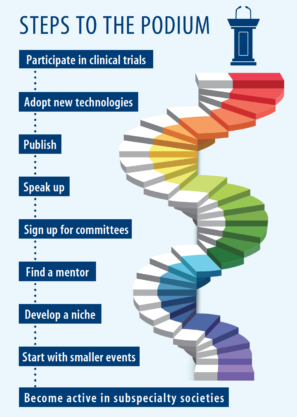There are more women in ophthalmology—and medicine in general—than ever before. Women now make up 20% to 30% of all ophthalmologists, notes Elizabeth Yeu, MD, and nearly half of US medical students and residents are female.1 Women are increasingly visible in practices, at the podium, and in academia. Times have changed dramatically since a young Marguerite McDonald, MD, heard a senior physician brag to a large group that he liked to hire female doctors because he could pay them so much less, but are these changes enough? CRST asked some respected female ophthalmologists in the United States as well as the president of Ophthalmic World Leaders (OWL) to share their thoughts and experiences.
To what do you attribute the growing number of women in ophthalmology?
Kendall Donaldson, MD: Aside from the simple increase in numbers, women have taken more leadership positions in ophthalmology and have assumed more of a presence at the podium at regional, national, and international meetings. I attribute some of these changes to women’s becoming better organized with groups that work together to promote women in ophthalmology such as Women in Ophthalmology.
Additionally, with decreasing reimbursement paradigms and the increasing presence of large groups and hospital-based practices, ophthalmology has become less lucrative and possibly less appealing to our male counterparts, who may now pursue more lucrative opportunities outside of medicine.
Jennifer Loh, MD: In general, more women are entering the field of medicine, so this helps increase our presence in all specialties. Also, the continued advances in technologies and surgeries make ophthalmology an exciting and attractive field for anyone.
Rosa Braga-Mele, MD, MEd, FRCSC: In the past 10 to 15 years, we have seen a surge in female ophthalmologists: more residents and more women graduating. Ophthalmology is seen as a great field to pursue. It is very competitive, and the lifestyle is good for men and women.
Cynthia Matossian, MD: Decades ago, women became nurses, or those who braved medical school were channeled into pediatrics or family medicine. It took a long time, but fortunately, many of the traditional barriers that prevented women from getting into medical school, let alone into a surgical residency such as ophthalmology, are behind us now.
At the same time, reimbursement is decreasing, patients’ expectations are increasing, and the field is becoming more technology driven, requiring continuous costly investments. My impression is that the longer schooling, the increased debt, and the decreased reimbursement with the slim profit margins are luring proportionally more men than women into alternate careers on Wall Street and at consulting companies, hedge funds, and large banking organizations. There is potentially more money to be made in the world of investment banking than in medicine if wealth happens to be a goal in one’s life.
Lisa Brothers Arbisser, MD: Unfortunately, one reason that ophthalmology does not attract as many men is that remuneration is falling. It is attractive for women, however, because of lifestyle and the ability to care for patients of all genders and ages without their having to disrobe, which reduces the embarrassment factor and self-selection by the patient population.
How is the presence of women at the podium changing?
Dr. Arbisser: I was often the only woman at the podium in the field of cataract surgery for many years. It is delightful to see this changing with all the talent represented by the contributors to this article and so many others.
Dr. Braga-Mele: Despite the growing numbers of women in ophthalmology, we do not see the same percentage at the podium or among the thought leaders. It is not the same ratio. Some women may feel that the podium is an old boy’s club and may have the perception that they cannot get in. Traditionally, more men attended the meetings and gave presentations widely. Women who were starting a family or starting a career did not always fell they could just leave and go to all of the meetings; however, recently, more changes have been made with respect to timing and commitment. It is more acceptable to say “no” to some invitations and still rise within the ranks. You do not have to be away from your family all the time to get there. This is not limited to women anymore. Many millennial men are not willing to sacrifice family for career.
How can women get more podium time?
Mildred M. G. Olivier, MD: The Pathway to the Podium Initiative seeks to work with program committees of national organizations to increase awareness about the lack of women in podium and leadership roles and to offer these organizations resources to fill the gap of women represented. It is within our power to make this change within ophthalmology. If each and every person in the room makes a commitment to add one more qualified woman to a program, panel, or committee that they would not have thought to otherwise, we can achieve this goal.

Heather Ready, MBA: Unfortunately, women have tended to wait for someone to ask us to be presenters. That might have been OK in high school, but it is not necessary when you have a compelling story. Network. Connect with people in the industry. Join groups like OWL and the American Society of Cataract and Refractive Surgery, and look for opportunities to engage with others. Committee work can lead to podium opportunities.
If you want to engage but do not want to speak at the podium, offer to be interviewed for articles, participate in roundtable discussions, or participate in a user meeting if you are using a technology, drug, or product. The more you get out there, the more likely you will be to have speaking opportunities.
Dr. McDonald: When I talk to my husband about this, he says, “People are not mind readers. You have to let them know you are interested in participating and share what topics you are interested in.” Email people, ask how you can get involved in committees, and reach out to mentors or fellowship directors.
Dr. Yeu: The good news is that there is no magic formula or one specific pathway to the podium. This is an earned privilege that begins with a professional desire to do more than “clock in and out” of work. If you have a niche or subspecialization clinically or in research, explore it as much as you can. Let others know, such as your colleagues who are involved with selecting speakers for meetings, and say yes to speaking opportunities that come your way. They may be local or regional venues initially, but as your confidence and poise at the podium grow, you will find greater opportunities to speak in front of larger audiences such as at the annual meetings of larger societies.
Do female ophthalmologists offer a unique skill set?
Dr. McDonald:Generalizations are always dangerous, but it seems that most women are unafraid of showing emotions. Of course, I know lots of touchy-feely male doctors (a good thing in my estimation), and I know women who are not like that, but if a patient needs to communicate on an emotional level, it seems more likely to occur with a female doctor.
Dr. Loh: I think a lot of female patients prefer women ophthalmologists if they have access to one. I always ask all of my patients why they chose me as their doctor, and often, the women will say it is because they wanted a female ophthalmologist. I theorize that perhaps they feel more comfortable with having similar styles of communication with their doctor. In any medical specialty, women physicians are able to bring a different perspective to care.
Ms. Ready: When you have diversity among physicians, you represent your patient base more effectively. You can relate to them and are more likely to address bias and understand issues related to age, gender, and culture.
Are there barriers that are specific to female ophthalmologists?
Dr. Donaldson: Women face unique challenges in balancing their home life with their work life. This is a constant battle that may tip in one direction or another at various stages throughout a woman’s life. With issues centering around maternity leave, children’s illnesses, and other family responsibilities, at times, women are unable to devote themselves fully to their work (particularly when their children are young). Also, since historically there have been fewer women in ophthalmology up until now, there are currently fewer mentors in the field for young female ophthalmologists.
Dr. Braga-Mele: Women should not feel guilty if they choose their family or if they choose their career. In reality, a choice does not have to be made. Some women are able to balance both endeavors. It is OK to be an ophthalmologist who goes home at the end of the day, and it is OK to want to do as many surgeries or speak at as many meetings as you can. There is no right or wrong answer, only what is right for the specific person.
Dr. McDonald: Beyond the actual challenges, women face a host of assumptions. People think, “She must be too busy. She is married. She has three kids. She must not be interested in being president of the local society.” It is, of course, erroneous and unfair to make this assumption. Having said that, the burden of parenting still falls mostly to the mother, so it is critical that couples work together to support each other. I see the beginning signs of change in this area. I hear young male MDs talking about what their wife, also an MD, is going through. It seems that the younger male physicians may have a bit more understanding and empathy than some (not all) of the older male physicians. Perhaps this is because their mothers were more likely to have been in the workplace when they were young. [These doctors] understand that a fulfilled mother is a better and more interesting mother (and wife). Regarding older male colleagues, I am delighted to see the transformation that they can undergo when they have daughters who are trying to make it in the workplace. These physicians hear their daughters’ stories, their challenges and frustrations. Suddenly, they see their female colleagues with new eyes.
Dr. Yeu: Preconceptions always exist for various groups, and people will have their biases. I am not immune to that. For this reason, I try my best not to take offense to some that I have encountered along the way. I have seen preconceptions that span the spectrum, from a growing body of patients who specifically seek out women clinicians because women often have a softer bedside manner to others who are more guarded because I am a young female physician. Patients who come to me from more rural areas are not used to having a nonwhite clinician, and that adds to their interest or angst when they meet me. I do think that positive patient experiences and a growing referral network within the community have certainly helped to allay any preconceived notions that patients may have prior to meeting me.
Dr. Arbisser: We still face the fact that biology requires that we bear and nurture the babies. If there were mandatory maternal and paternal leave, as in some more enlightened societies, women would not always be at a disadvantage in the workplace in all fields. Stable childcare extenders need to be a priority. With regard to ophthalmology, it is much easier to reach the surgical field during the ninth month of pregnancy since we moved to temporal incisions!
What is the role of mentorship in a woman’s career journey?
Dr. Donaldson: The key to the success of women in ophthalmology is our continued efforts to work together as a group. As women assume more leadership roles, this gives them the authority to provide opportunities for other women to take roles in various programs or projects (research, paper writing). Organized mentorship programs may also play a role in fostering the development of women in ophthalmology.
Dr. Yeu: We should support each other for different commonalities like gender and ethnicity. I love being able to look up to other women: Dr. McDonald paved the way for strong women ophthalmologists, and Bonnie An Henderson, MD, has given me sound advice throughout my young career. I make every effort to look out and lift up other young women surgeons when they seek advice. Mentorship and collaborative relationships are vital to help raise the tide for our field.
Ms. Ready: It is important to look beyond the idea of mentorship and consider sponsorship instead. When someone sponsors you, he or she is stepping forward and saying, “I believe this person has skills, ability, and capabilities that we need as an organization to nurture and develop.” A sponsor is vested in your success. He or she can engage you in special projects and help you to reach the next level. Sponsorship is a more involved relationship. You are both on the same side of the table.
Dr. Braga-Mele: Women need to support women. We need to stand on the backs of each other and support each other. We should talk to each other to see how people are managing when they do not want to give up career for family but neither do they want to neglect family. We can share ideas and support. Mentors do not have to be women. Both men and women make excellent mentors who can help women get more involved at the podium and in research. I had an excellent male mentor who never made me felt marginalized. (See Dr. Salim’s article on mentoring)
RESOURCES FOR WOMEN IN OPHTHALMOLOGY
• A merican Medical Association Women’s Section
bit.ly/AMAwomen
• A merican Medical Women’s Association
www.amwa-doc.org
• Group on Women in Medicine and Science
www.aamc.org/members/gwims
• Lean in Negotiation Information
leanin.org/education/negotiation
• Medical Women’s International Association
mwia.net
• Ophthalmic World Leaders (OWL)
www.owlsite.org
• Women in Ophthalmology
www.wioonline.org
What can women do to develop career skills?
Dr. Henderson: Women (and men) are sufficiently trained with respect to their medical and surgical knowledge, but we are not trained to be effective leaders. I believe we need to grow our communication skills (public speaking, communication with staff/other physicians, etc.), managerial skills, and financial acumen to excel in our careers. Being a successful physician is no longer just about being a good doctor; it is about being able to navigate the politics of your workplace, assessing financial situations, and sometimes having the courage to take a stand. There are executive leadership courses offered at most universities as well as online. We all engage in continuing medical education, but this type of education may be equally important.
Ms. Ready: We all need to engage and be active in our own personal development. That could mean taking a course or reaching out to people who have skills we want to learn. We always have to be learning; we never just stop.
It keeps your passion and energy going if you are learning something new. If you feel that there is a weak link in your learning curve, find a way to address it. Let’s say you have a fear of speaking in public. You can work to overcome that by presenting in a “safe zone” such as an OWL event. Serve on a panel, join a committee, or lead a group among people who want you to be successful.
A recent study showed that there is a wage gap in ophthalmology and that female ophthalmologists make 58 cents for every $1 their male counterparts make.2 Why do you think that is?
Dr. McDonald: There are still big gaps in our salaries between what we make and what men with the same background and skill set are making. The data show that we are submitting fewer charges and billing for fewer procedures.2 I think we need to take a “deep dive” into this situation to figure out why this is the case. Are we spending fewer hours in the office and OR in order to take care of our families? Are we not well trained in coding? Are we relatively too empathetic (ie, not coding for some of our procedures because of sympathy for our patients’ financial plights)? Are the high-ticket procedures being directed by the front desk to other members of the practice? Are we less skilled at negotiating bonuses and other benefits?
Dr. Yeu: A lot of younger women are working less than full time or in a shared position as they are raising a family.
Dr. Arbisser: The report on the salary gap noted that women submit fewer charges.2 You have to buy a ticket to win the lottery. Perhaps we should consider aggressive legal coding seminars for meetings along with wet labs.
Ms. Ready: Women do not tend to negotiate. I do not know if we are undervaluing ourselves or are not confident at saying we deserve more money. Maybe we are fearful that, if we ask, we may lose the opportunity. The good news is that younger women coming in seem to be more comfortable asking and negotiating.
1. Chang D. The shortage of women in ophthalmology. EyeWorld. http://bit.ly/shortageofwomen. Published August 2011. Accessed March 30, 2017.
2. Reddy AK, Bounds GW, Bakri SJ. Differences in clinical activity and Medicare payments for female vs male ophthalmologists. JAMA Ophthalmol. 2017;135(3):205-213.














